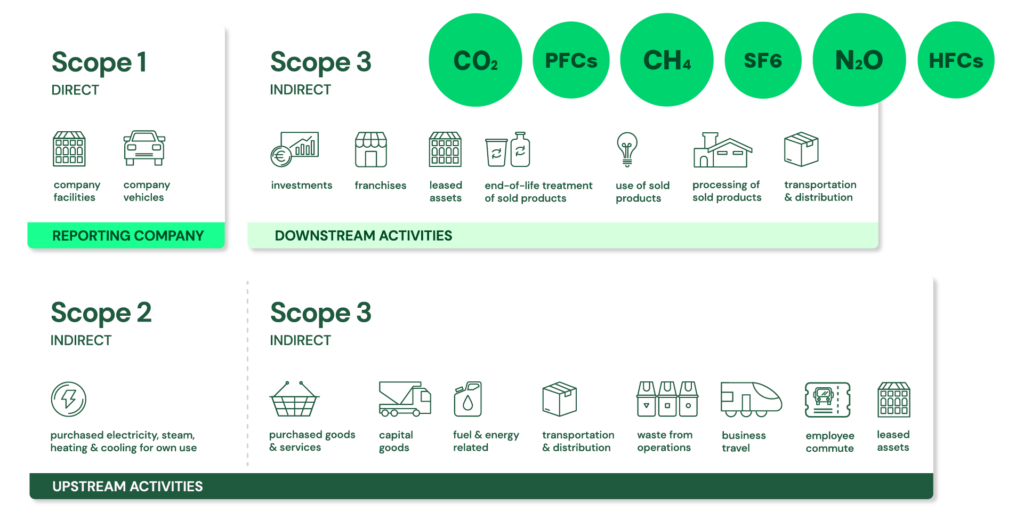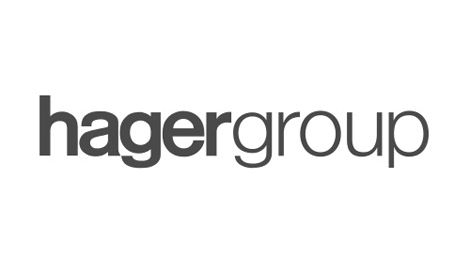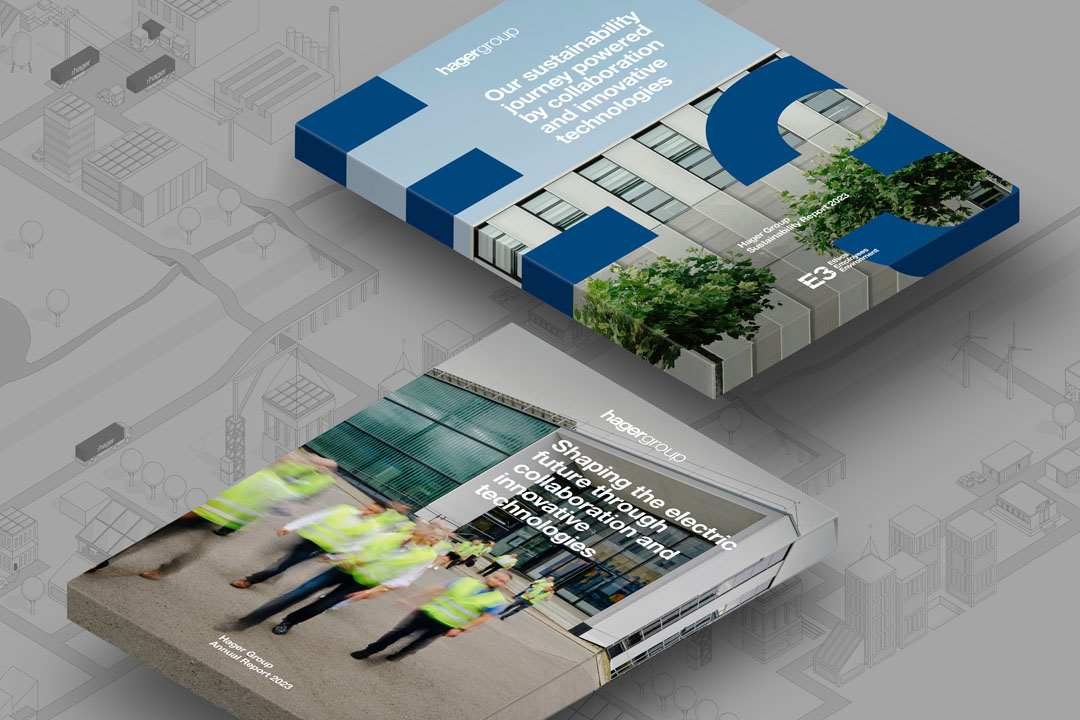Hager – Discover Hager Group’s 2023 Annual and Sustainability Reports, showcasing a 12.3% turnover growth and commitment to sustainability and innovation.
Hager Group released its 2023 Annual and Sustainability Reports, accelerating sustainability through innovative technologies.
The company achieved a 12.3% increase in turnover, reaching €3.2 billion due to strategic acquisitions and digital advancements, such as the successful integration of Pmflex and Eficia. Adopting SAP S4/HANA notably enhanced operational efficiency and customer data management across over 50 subsidiaries.
Hager Group’s commitment to sustainability is evident in its comprehensive sustainability strategy E3, focusing on ethics, employees, and the environment. The 2023 sustainability report, following GRI standards, highlights the company’s progress and daily practices in transitioning to a low-emission business and its role as a facilitator of the energy transition. The report reveals a 14% reduction in CO2 emissions directly connected with operations and processes (scope 1+2) in 2022 through renewable energies and investments in renovations and construction for high sustainability standards. Furthermore, Hager Group was awarded the Ecovadis Gold certification in early 2024, placing the company among the top 5% globally rated companies.
CEO Sabine Busse emphasised, “In 2023, Hager Group showed strong financial and non-financial performance. Our strategic initiatives and commitment to sustainability have driven growth and efficiency improvements. Digitalising our products, processes, and tools is especially crucial as it enables us to become more sustainable. I am proud of our teams’ dedication to innovation and environmental responsibility, positioning us as a leader in the industry and a catalyst for the energy transition.”
Chief Human Resources Officer Franck Houdebert added, “Caring for our people and promoting an inclusive culture are central to our performance and sustainable success. Our strategic actions in sustainability benefit the environment and enhance employee engagement and organizational resilience. Our collective effort enables us to achieve these remarkable milestones.”
Hager Group has strengthened its position as a leading company in the energy transition by focusing on sustainability, digital innovation, and customer-centric solutions. It operates in over 100 countries with over 13,000 employees and is committed to creating long-term value for its customers, partners, and employees.
The full Annual Report and Sustainability Report can be downloaded from the Hager Group website.
SourceHager Group
EMR Analysis
More information on Hager: See the full profile on EMR Executive Services
More information on Sabine Busse (Group Chief Executive Officer, Hager): See the full profile on EMR Executive Services
More information on Michael Flieger (Chief Financial Officer, Hager Group): See the full profile on EMR Executive Services
More information on Franck Houdebert (Chief Group Human Resources Officer and the Board of Director’s Sustainability Ambassador, Hager Group): See the full profile on EMR Executive Services
More information on the Hager Sustainability Strategy, E3, the Hager CSR Approach and on the Hager Sustainability Report 2023: See the full profile on EMR Executive Services
More information on Matthieu Alexandropoulos (Corporate Social Responsibility (CSR) Corporate Director, Hager Group): See the full profile on EMR Executive Services
More information on Pmflex srl by Hager: https://pmflex.com/ + PM FLEX is the European specialist in electrical conduits. Founded in 1962, PM, with an yearly production of 330.000 Km of conduits, is the leading european manufacturing company of insulating conduit systems for electrical installation of any type and size. Particularly, PM is the number 1 manufacturer in Europe of pre-wired conduits for production capacity (more than 100.000 Km/year) and product range (more than 700 SKU’s). Headquarter and production facilities are located in Italy, 60 Km far from Milan. PM Flex Holding AB is the controlled sales company based in Gotheborg (Sweden) selling PM products under the “PM FLEX” brand in Sweden, Norway, Finland and Denmark. Innovation, environmental care and customer care are the key pillars of PM mission.
PM FLEX achieved a low-triple digit million Euros turnover (2021). The products of Pmflex are sold in more than 50 countries worldwide.
The company operates from two production facilities in Almenno San Bartolomeo, close to Bergamo in northern Italy.
More information on Frédéric Soler (Managing Director, Pmflex Group, Hager): See the full profile on EMR Executive Services
More information on Leif Hallén (Managing Director Hager Europe Region, zone North and Sweden, Hager + Managing Director, Pmflex Group Northern Europe AB, Hager ): See the full profile on EMR Executive Services
More information on Efficia by Hager: https://eficia.com/ + Eficia is a young company specializing in the energy management of buildings created in 2013. From its inception, Eficia wanted to revolutionize the sector by developing the first 24/7 smart building solution and remain to this day the only 360° GreenTech on the market that is 100% integrated to cover all the major areas of expertise in energy management.
More information on Alric Marc (Chief Executive Officer, Efficia, Hager Group): See the full profile on EMR Executive Services
More information on SAP: https://www.sap.com/germany/about/company.html + As the market leader in business software, SAP helps companies of all sizes and industries to be more successful: 87% of global trade volume is generated by SAP customers. Our machine learning, Internet of Things (IoT) technologies and advanced analytics support our customers on their journey to the intelligent enterprise. Our end-to-end suite of applications and services enables our customers to operate profitably, continuously adapt and differentiate themselves from the competition.
>105,000 employees from 157 countries.
24,000+ SAP partner companies globally.
€29.52b total revenue (non-IFRS) in FY2022.
More information on Christian Klein (Chief Executive Officer, SAP): https://www.sap.com/about/company/leadership/christian-klein.html + https://www.linkedin.com/in/christian-klein/
More information on SAP S/4HANA by SAP: https://www.sap.com/products/erp/s4hana.html + SAP S/4HANA Cloud, public edition is a ready-to-run cloud ERP that delivers the latest industry best practices and continuous innovation.
More information on Global Reporting Initiative (GRI): http://www.globalreporting.org/ + GRI is an independent international organization that has pioneered sustainability reporting since 1997. GRI helps businesses and governments worldwide understand and communicate their impact on critical sustainability issues such as climate change, human rights, governance and social well-being. This enables real action to create social, environmental and economic benefits for everyone. The GRI Sustainability Reporting Standards are developed with true multi-stakeholder contributions and rooted in the public interest.
More information on EcoVadis: https://ecovadis.com + The World’s Most Trusted Business Sustainability Ratings.
Since its founding in 2007, EcoVadis has grown to become the world’s largest and most trusted provider of business sustainability ratings, creating a global network of more than 125,000+ rated companies.
Our team is composed of over 1700 highly-talented professionals from 80 nationalities.
The EcoVadis sustainability assessment methodology is at the heart of our Ratings and Scorecards and is an evaluation of how well a company has integrated the principles of Sustainability/CSR into their business and management system.
Our methodology is built on international sustainability standards, including the Global Reporting Initiative, the United Nations Global Compact, and the ISO 26000, covering 200+ spend categories and 180+ countries.
More information on Pierre-François Thaler (Co-Founder & Co-Chief Executive Officer, EcoVadis): https://ecovadis.com/leadership/ + https://www.linkedin.com/in/pfthaler/
More information on Frédéric Trinel (Co-Founder & Co-Chief Executive Officer, EcoVadis): https://ecovadis.com/leadership/
EMR Additional Notes:
- Carbon Dioxide (CO2):
- Primary greenhouse gas emitted through human activities. Carbon dioxide enters the atmosphere through burning fossil fuels (coal, natural gas, and oil), solid waste, trees and other biological materials, and also as a result of certain chemical reactions (e.g., manufacture of cement). Carbon dioxide is removed from the atmosphere (or “sequestered”) when it is absorbed by plants as part of the biological carbon cycle.
- Biogenic Carbon Dioxide (CO2):
- Biogenic Carbon Dioxide (CO2) and Carbon Dioxide (CO2) are the same. Scientists differentiate between biogenic carbon (that which is absorbed, stored and emitted by organic matter like soil, trees, plants and grasses) and non-biogenic carbon (that found in all other sources, most notably in fossil fuels like oil, coal and gas).
- Carbon Capture and Storage (CCS):
- CCS involves the capture of carbon dioxide (CO2) emissions from industrial processes. This carbon is then transported from where it was produced, via ship or in a pipeline, and stored deep underground in geological formations.
- CCS projects typically target 90 percent efficiency, meaning that 90 percent of the carbon dioxide from the power plant will be captured and stored.
- Decarbonization:
- Reduction of carbon dioxide emissions through the use of low carbon power sources, achieving a lower output of greenhouse gasses into the atmosphere.
- Carbon Footprint:
- There is no universally agreed definition of what a carbon footprint is.
- A carbon footprint is generally understood to be the total amount of greenhouse gas (GHG) emissions that are directly or indirectly caused by an individual, organization, product, or service. These emissions are typically measured in tonnes of carbon dioxide equivalent (CO2e).
- In 2009, the Greenhouse Gas Protocol (GHG Protocol) published a standard for calculating and reporting corporate carbon footprints. This standard is widely accepted by businesses and other organizations around the world. The GHG Protocol defines a carbon footprint as “the total set of greenhouse gas emissions caused by an organization, directly and indirectly, through its own operations and the value chain.”
- CO2e:
- CO2e means “carbon dioxide equivalent”. In layman’s terms, CO2e is a measurement of the total greenhouse gases emitted, expressed in terms of the equivalent measurement of carbon dioxide. On the other hand, CO2 only measures carbon emissions and does not account for any other greenhouse gases.
- A carbon dioxide equivalent or CO2 equivalent, abbreviated as CO2-eq is a metric measure used to compare the emissions from various greenhouse gases on the basis of their global-warming potential (GWP), by converting amounts of other gases to the equivalent amount of carbon dioxide with the same global warming potential.
- Carbon dioxide equivalents are commonly expressed as million metric tonnes of carbon dioxide equivalents, abbreviated as MMTCDE.
- The carbon dioxide equivalent for a gas is derived by multiplying the tonnes of the gas by the associated GWP: MMTCDE = (million metric tonnes of a gas) * (GWP of the gas).
- For example, the GWP for methane is 25 and for nitrous oxide 298. This means that emissions of 1 million metric tonnes of methane and nitrous oxide respectively is equivalent to emissions of 25 and 298 million metric tonnes of carbon dioxide.
- Carbon Credits or Carbon Offsets:
- Permits that allow the owner to emit a certain amount of carbon dioxide or other greenhouse gases. One credit permits the emission of one ton of carbon dioxide or the equivalent in other greenhouse gases.
- The carbon credit is half of a so-called cap-and-trade program. Companies that pollute are awarded credits that allow them to continue to pollute up to a certain limit, which is reduced periodically. Meanwhile, the company may sell any unneeded credits to another company that needs them. Private companies are thus doubly incentivized to reduce greenhouse emissions. First, they must spend money on extra credits if their emissions exceed the cap. Second, they can make money by reducing their emissions and selling their excess allowances.
- Global Warming:
- Global warming is the long-term heating of Earth’s climate system observed since the pre-industrial period (between 1850 and 1900) due to human activities, primarily fossil fuel burning, which increases heat-trapping greenhouse gas levels in Earth’s atmosphere.
- Global Warming Potential (GWP):
- The heat absorbed by any greenhouse gas in the atmosphere, as a multiple of the heat that would be absorbed by the same mass of carbon dioxide (CO2). GWP is 1 for CO2. For other gases it depends on the gas and the time frame.
- Carbon dioxide equivalent (CO2e or CO2eq or CO2-e) is calculated from GWP. For any gas, it is the mass of CO2 which would warm the earth as much as the mass of that gas. Thus it provides a common scale for measuring the climate effects of different gases. It is calculated as GWP times mass of the other gas. For example, if a gas has GWP of 100, two tonnes of the gas have CO2e of 200 tonnes.
- GWP was developed to allow comparisons of the global warming impacts of different gases.
- Greenhouse Gas (GHG):
- A greenhouse gas is any gaseous compound in the atmosphere that is capable of absorbing infrared radiation, thereby trapping and holding heat in the atmosphere. By increasing the heat in the atmosphere, greenhouse gases are responsible for the greenhouse effect, which ultimately leads to global warming.
- The main gases responsible for the greenhouse effect include carbon dioxide, methane, nitrous oxide, and water vapor (which all occur naturally), and fluorinated gases (which are synthetic).

- GHG Protocol Corporate Standard Scope 1, 2 and 3: https://ghgprotocol.org/ + The GHG Protocol Corporate Accounting and Reporting Standard provides requirements and guidance for companies and other organizations preparing a corporate-level GHG emissions inventory. Scope 1 and 2 are mandatory to report, whereas scope 3 is voluntary and the hardest to monitor.
- Scope 1: Direct emissions:
- Direct emissions from company-owned and controlled resources. In other words, emissions are released into the atmosphere as a direct result of a set of activities, at a firm level. It is divided into four categories:
- Stationary combustion (e.g fuels, heating sources). All fuels that produce GHG emissions must be included in scope 1.
- Mobile combustion is all vehicles owned or controlled by a firm, burning fuel (e.g. cars, vans, trucks). The increasing use of “electric” vehicles (EVs), means that some of the organisation fleets could fall into Scope 2 emissions.
- Fugitive emissions are leaks from greenhouse gases (e.g. refrigeration, air conditioning units). It is important to note that refrigerant gases are a thousand times more dangerous than CO2 emissions. Companies are encouraged to report these emissions.
- Process emissions are released during industrial processes, and on-site manufacturing (e.g. production of CO2 during cement manufacturing, factory fumes, chemicals).
- Direct emissions from company-owned and controlled resources. In other words, emissions are released into the atmosphere as a direct result of a set of activities, at a firm level. It is divided into four categories:
- Scope 2: Indirect emissions – owned:
- Indirect emissions from the generation of purchased energy, from a utility provider. In other words, all GHG emissions released in the atmosphere, from the consumption of purchased electricity, steam, heat and cooling. For most organisations, electricity will be the unique source of scope 2 emissions. Simply stated, the energy consumed falls into two scopes: Scope 2 covers the electricity consumed by the end-user. Scope 3 covers the energy used by the utilities during transmission and distribution (T&D losses).
- Scope 3: Indirect emissions – not owned:
- Indirect emissions – not included in scope 2 – that occur in the value chain of the reporting company, including both upstream and downstream emissions. In other words, emissions are linked to the company’s operations. According to GHG protocol, scope 3 emissions are separated into 15 categories.
- Scope 1: Direct emissions:



